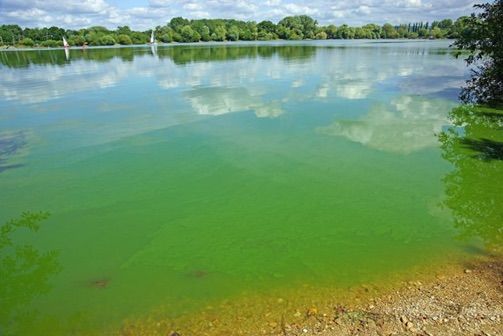Science Corner: Toxic Algae, aka Cyanobacteria

Photo by Centers for Disease Control
It seems to be a fairly familiar summer local news story; beware - toxic algae may be present in neighborhood ponds. Often called toxic algae, in reality, it’s not an algae at all that threatens our summer fun; it is Cyanobacteria.
Blue-green algae is often given credit for changing Earth’s lifeforms by being the first known organism able to photosynthesize and produce oxygen - the basis of life on Earth. They are among the oldest known organisms with fossil records that date back over two billion years ago. However, blue-green algae isn’t an algae at all, it’s actually a specialized bacteria and belongs to one of the most numerous taxon - Cyanobacteria. Named for their color and identified by their pigments and ability to photosynthesize, they are an extremely important component in marine food webs. They naturally occur in fresh, brackish and marine environments and thrive in low oxygen environments. This charismatic bacteria that kick-started life as we know it also contains lethal toxins that can also be deadly to pets, people, livestock and wildlife.
When the weather gets warm, isolated bodies of water such as retention basins, stock ponds and even unmaintained backyard pools and fountains become stagnant. Nutrients from over-fertilizing and then over-watering lawns and gardens run off and can collect in neighborhood retention ponds causing eutrophication - when organisms such as algae and bacteria reproduce explosively in warm, nutrient rich waters depleting the oxygen level and resulting in environmental degradation. The optimal conditions for a cyanobacteria bloom.
Warm, oxygen deprived water brimming with organisms that thrive in these conditions can result in an overabundance or “bloom”. Some cyanobacteria contain lethal toxins and when present in out of control numbers decompose aquatic ecosystems and can cause potentially lethal intoxication of pets, people, livestock and wildlife if they come into contact with it. Cyanobacteria is too small to be seen with the naked eye but when conditions result in a bloom, gobs of bacteria collect on the surface of the water and may look like mats of floating vegetation, foam, pond scum, or even a film of paint or oil floating on the water. Colors range from vibrant greens and blues to yellow, red and brown and sometimes the mats sink which causes the water to smell like rotting vegetation or worse.
Cyanobacteria can produce different types of toxins including liver and neurotoxins which can cause serious illness and sudden death. Dogs are especially at risk because of their infatuation with water, the stinkier the better (according to them). They can ingest cyanobacteria by drinking contaminated water directly or by simply fetching an object that was tossed into the water. They can also get it just from licking the bacteria-laden water off of their wet paws and fur. Depending on which type of toxin they were exposed to, symptoms can arise less than 15 minutes to a couple of days after exposure and may include diarrhea or vomiting, drooling or foaming at the mouth, jaundice and neurologic signs such as weakness, disorientation, seizures and difficulty breathing. If you know your dog was in contact with cyanobacteria, immediately and thoroughly rinse them off with fresh water and urgently get them to the veterinarian. If caught very early, the vet may be able to flush out the toxins.
To help keep you and your dog safe, keeping them leashed around water, especially if it appears dirty, foamy or has mats floating on top is always a good idea and bring plenty of fresh water for them to drink. Although not all cyanobacteria is harmful, there are no clinical tests, designated treatments or antidotes so when in doubt, keep them out.
-Kristie Ehrhardt (kehrhardt@tuleyome.org)
Tuleyome Land Conservation Program Manager
RECENT ARTICLES






